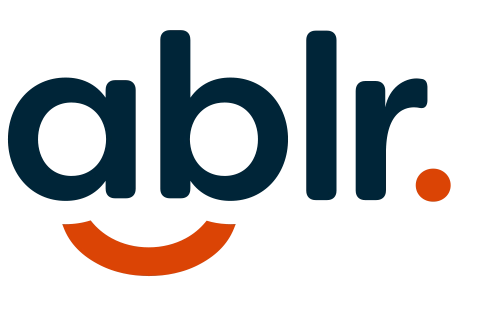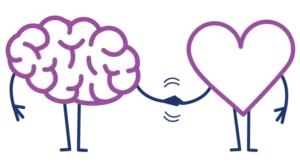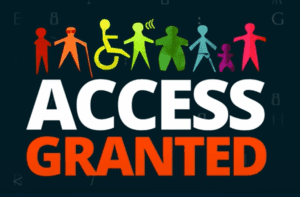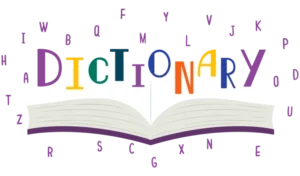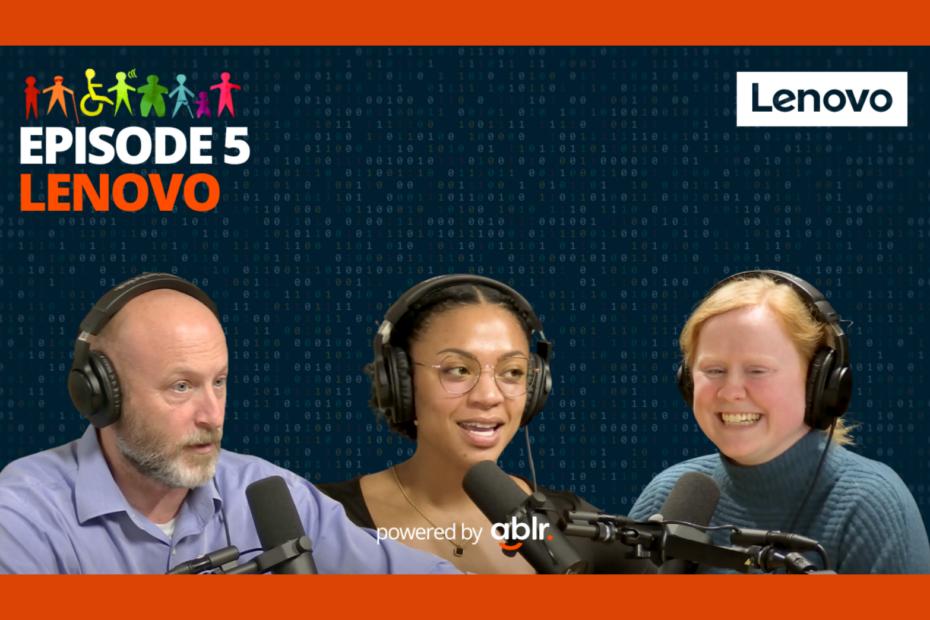Access Granted: Lenovo Part 1 Transcript. Tune in wherever you listen to podcasts.
Mike Iannelli: Welcome to Access Granted, the podcast exploring the intersection of disability, equity, inclusion, and accessibility. And today we have a truly special episode in store for you. Joining me are two remarkable individuals from Lenovo, Onyx Mintah, the UX program strategist and Collaboration Lead, and Sara Weir, a UX researcher.
Together, they’ve been driving forward a groundbreaking project in assisted technology, utilizing various procedures and approaches to ensure inclusivity and accessibility. Join us as we explore their collaborative journey and learn about the profound impact of their efforts. I can’t wait for you to hear from these big advocates for accessibility in the tech space.
So welcome. Super glad you’re here. I really am. To see how you all move so fluidly and, and you collaborate together as a unit is very impressive. I mean, a lot of organizations don’t function quite that way. Before we kind of jump into some questions, I want to. Talk to me or share with me a little bit about sort of
how you all do that, because that’s impressive. And then obviously communication, obviously training, obviously compassion, obviously empathy, all those things. But talk about how you were able to together, come together at a company that size with a goal in mind for something that was driven or derived out of the future of what you want your tech to be.
Sara Weir: Like high level, what makes our team unique, like within Lenovo is the fact that research and design work so closely together. And we work together on all the projects. There’s usually always a researcher and a designer and we help each other throughout the process. And so our handoffs are really direct.
We know and work together on what we need from certain activities and to help each other throughout the process. So whether that’s at the beginning, like fuzzy front end or into product testing. And so I think that’s really a standout thing for our team, because a lot of companies have researchers and designers working closely, but not actually together.
And so things are handed off between them. And I think some things are lost that way. And so I think that is where our success stems from.
Onyx Mintah: I would also say that in this particular case, because we are all very passionate about this topic. From the very beginning, we’ve been championing this and, you know, having conversations with a wide array of people.
And, when it comes to accessibility, I think a lot of people are either shy or don’t want to make a mistake. We’ve heard that a lot in a lot of the conversations we’ve had. But I think us as individuals, and as NEXT UX, we care so deeply about what it is that we’re doing. That’s what takes precedence, versus, you know, different areas where politics can kind of take over, you know. Accessibility is less about, you know, who’s doing the coolest what and how can we actually make our products better? How can we make things and create experiences that are for our users?
Mike Iannelli: Yeah I mean, you talk about, you said the word caring. Like that to me, like that’s everything. Like you can go through the motions in your career and get a paycheck and then move on.
But truly it’s like, are you fulfilled? Are you, are you, do you have meaning, right, in life? And a lot of times in life, we always search for that. But I think caring is such a critical piece. And I want to take it just a quick step back, as you said NEXT UX. And I want to talk about UX because, you know, UX means, can mean different things to different people. Especially when you start talking about universal UX.
Talk to me about UX, your position personally, and, and if it’s, if it’s shared at the organization. And then how does accessibility and universal UX kind of come into play? Let me pass it, Onyx, you take it first if you want, and we’ll pass it back to Sara, but I’d love both your opinions on that.
Onyx Mintah: Yeah sure.
I think, I am not a designer or a researcher by trade. So I think Sara will have a lot of insight into this topic, but I do. I have noticed that even in the almost two years that I’ve been at Lenovo, there’s been a huge push to focus on user experience. I mean top leadership is talking about it.
And whereas before I’ve only been in UX for maybe like five, six years. It was kind of like, okay we have to have this because it’ll make people buy more products. Whereas now it’s more like we care about the experience that our customers are having, and it’s constantly brought up. And, I’ve noticed that even this year, it’s been less of a, I wouldn’t say like dragging people along to try and get them to understand or care.
But because leadership is highlighting how important this is, people are listening more often.
Mike Iannelli: And you know that before you jump in Sara. It’s such an important point because you’re talking about the top down. The purpose of this show and you guys kind of, we talked about this before, was bringing in clients that have courage and that want to make change. And it’s, it’s difficult and it shouldn’t be, to speak up and stand up for something that, that you believe in, and especially in a large environment that has thousands of employees. And you, you may be just a number, but it doesn’t feel like at Lenovo, you’re just a number.
It feels like you’re giving, you’re given the opportunity to spread your wings, to put your own personal touch on things, and they actually value their employees to drive their business. Is that, is that a true statement?
Sara Weir: 100%.
Onyx Mintah: I would definitely say from our team specifically as well, NEXT UX has a really unique position and our director is somebody who’s pushed to even create NEXT UX. And that in and of itself shows how our team, within Lenovo, strives to be different and to be courageous because our team didn’t exist a couple of years ago. Our director created it.
Mike Iannelli: Which is, okay let’s give a shout out to your director. What’s their name?
Sara Weir: Aaron Stewart.
Onyx Mintah: Aaron Stewart.
Mike Iannelli: Well done, Aaron. Can we do a tag on that? Did you, that was like a, was that, was that like a game sound? Like, yeah, yeah, yeah. You probably went to the Hurricanes there. Yeah, whatever that was.
Alright, talk about NEXT UX again. So this is an internal division department focus, approach, just at Lenovo? Or is this sort of a global sort of a position on this?
Sara Weir: NEXT UX is our team name. I can give a little bit of background on the team. NEXT UX is the kind of sister team of our main UX team. And so what makes us different is that we work outside of the typical product cycle and look two to three years ahead. So we are more future focused. And so we’re on a team of about 14 people now. And we’re mixed of, researchers, designers, collaboration leads, service designers, and we have a wide background of skill sets. Combining people with engineering, ergonomics, human factors, industrial design, graphic design, all different sorts of things that I think create a really unique mesh of mindsets and experiences.
And we have a lot of different program areas that we get to work in and yeah.
Mike Iannelli: So you said two, three years out?
Sara Weir: Yep.
Mike Iannelli: The organization you said has only been a couple years old, you’ve been only here for two years at Lenovo, but how long has NEXT UX been in with Aaron’s vision? How long has that been working?
Sara Weir: I want to say about 10 years.
Onyx Mintah: I think a little less than 10 years.
Mike Iannelli: So have you seen, I’m guessing you have if you’re looking two, three years, have you seen work that has been done at NEXT UX come to fruition and go into the marketplace yet?
Sara Weir: So it’s a little bit tricky because our team works on projects.
And then we, we do share work to external stakeholders, but we often share internally. So we will share our work and projects to internal collaborators. So maybe the larger UX team, maybe the industrial design team, maybe services, sustainability. And we kind of see if there’s any interest from those stakeholders.
And so I think a lot of the times we don’t maybe see the direct concept, what we can see where our kind of brain power and ideas and research and insights influenced other concepts that are out on the market.
Mike Iannelli: See, I love that because what a cool gig, right? Like you guys get to work on things that aren’t there yet. And you have to use a much broader mindset to think about the future needs of tomorrow, yet you do that for the largest computer company in the world, which is amazing.
So Collaboration Lead, I want, I want to ask you about this cause, so one, explain that to me first, because.
Onyx Mintah: I’m only laughing because Collaboration Lead, there, there was a specific, you know, when they were hiring me for this role, there was specific role outlines and you know, what was expected. But coming on the team, because we work in so many different areas and because we are so multifaceted, each program area is focused on a very different, maybe not very different, but in a different part of products or services.
It’s so challenging to find the right people, come in at the right time, gather all the correct information, keep up with all of those things. And I think my role came out of the complexity with which NEXT UX works within. And it’s, my role is still being defined. And I was brought on with that being something that was attractive to me. Because I think that as, I mean as even as individuals having the opportunity to grow with a role that also grows with you
is incredibly unique and it’s a wonderful opportunity. Through and through my favorite thing to do is support my teammates. I’m not a star player by any means at all so.
Sara Weir: That’s a lie. She is definitely a star player.
Mike Iannelli: All American over here.
Onyx Mintah: That never happened. Collaboration Lead to me is to do anything and everything I can to support my coworkers, my teammates, to successfully grow an opportunity and have all of the pieces, people, information, whatever that looks like, organization that they need, in order to do that successfully.
Mike Iannelli: And you, so the reason why I asked that is again, I, we joke a little bit, but you know, you were a college athlete. I played a little sports in college. I don’t know if you played sports.
Onyx Mintah: So you were also a college athlete?
Mike Iannelli: I wasn’t, I was. Collaboration Lead to me is you’re pulling in all the pieces, right? And, and that’s not an easy thing to do. But when you start factoring in accessibility and inclusion and design and research and all these pieces. And you said, hey I’m fairly new to this.
I’m learning and growing as I come along. I think I would assume that your background in athletics plays a major role in your ability to do your job.
Onyx Mintah: I think it’s like one of the only reasons why I can do it, sincerely, really. And also to be able to like want to work with a wide array of people. There are different personalities, different interests. And I think sports kind of like humanizes and levels everything. And it kind of takes away that like, oh, I’m going to go and speak to a director, or I’m going to go and speak to, you know like, I don’t know, somebody super high up in the, in the chain of command.
Instead, I kind of approach it as like, this person is trying to get something done, let me just go and ask them a question. If it works great. If it doesn’t, I’ll move on. But my drive to support my team far outweighs my like, I don’t know if I should do this. Yeah, you do it because you’re supporting your team.
Mike Iannelli: One of the things I saw when I, so when I walked in, one, I was. So it was great to be there. I mean, I took some pictures when we were pulling up and, you know, we’re still an organization that’s growing and you guys know this. And it’s exciting that you’re part of this because we’re, we’re going to really cool places and I’m beyond humbled and honored to be part of it.
And truthfully, very honored and humbled to be working with you all. I mean, I mean that sincerely. And to see how it all came through though. It was like when I walked in that day and you were at the table doing the testing, the training. She was too, but you were separate. You’re both in different rooms.
Onyx Mintah: Yeah but she organized all of it.
Mike Iannelli: Yes. I know. But what I thought was cool is you were sitting at the table. So I didn’t know, see I thought that you were just like collaborating, gathering the team, doing all that, but you were still doing the work too. You were still part of the whole process. Which, and I knew that you were driving all of this, but what I thought was amazing about it was that you were still both together on it the whole day.
It wasn’t like you had a, I guess my point is, a lot of times in organizations it’s like “I have a role, I do my role, I check out.” But what I witnessed there was, I have a role but I’m not checking out. I’m gonna follow this through. And it was a such a team effort.
And then to see Ellis in there and the three of you were just like rolling. It was like, it was really cool to watch. Like Logan and I were talking afterwards, like we’ve really had a good time like just being part of it. So, so when you all, is that how it typically happens?
Sara Weir: I am speaking just to projects that I’ve been on.
I typically like to include, as many of the project team members that want to be included in the research actively as, as I can. I think it’s, especially in more kind of complex projects, like I consider this past one to be, there’s a lot going on and it’s not a one-person job. And so having Onyx there specifically in that scenario, Onyx was helping check people in, make sure everyone knew where to go, taking notes during the sessions. That helps me and other people afterwards not have to go kind of back and parse through things as much. It is really helpful. And I personally find having designers and collaboration leads along the way in the research process yields better insights later on because they were actively there and they saw what’s happening and they’re immersed in it too.
And I think that’s the best way to do it if everyone wants to and it’s possible.
Mike Iannelli: I think that’s incredible. Again, worked at big companies, worked at small companies. I just found it was pretty cool at a big company to see everyone working together like that. It felt like it was a small company mentality in a huge organization.
Sara Weir: Definitely.
Mike Iannelli: Is what it felt like.
Sara Weir: I think that’s our team and kind of following up on Onyx’s role. I think that applies a little bit to everyone on our team. I feel like if everyone has at times worn multiple hats. And if something needs to get done, then people jump in to help and get it done on a project. And I think that’s another reason why our team is really great.
Mike Iannelli: Yeah, you guys love your team. Aaron, I don’t know if Aaron’s hearing this but.
Sara Weir: Another awesome collaboration, she was not actively in this project, but we needed another person who felt comfortable leading the session. And so she just jumped in like two days before and was like, yes we’re going to do it.
Mike Iannelli: Yeah. I see, that’s incredible. Yeah. So tell me about like your role in research. What are some of the things that you do, again, that’s tied a little bit into accessibility too. Because you’re talking about the future of product. So take me through like a little bit of a day or take a project or something in your head where, how do you go about your business? I’m interested in that.
Sara Weir: Oh man that’s a big question.
Mike Iannelli: Well it is, but also tying a little bit of the, because I’m really interested in the accessibility piece. Because 25 percent market share, right? This is an opportunity for an organization to truly drive change. Like this isn’t small.
You all are leading in a major shift. And I think that’s amazing. And I want to talk a little bit about that and how you approach that.
Sara Weir: Yeah, I think it’s funny that you mentioned data. My background is in math and econ. So I did kind of data and like the analytics side and then switched and I got a degree in industrial design. And kind of along the way balanced and learned that I love interacting with people and incorporating them in the design process. And that’s kind of what I built on. And so I found our team and it again really intertwines research and design. And so for me personally, research, I love being in anything with people and getting individuals involved in the design and research process as quickly as possible.
I think that I personally thrive in kind of the kind of both ends of the research scale. Like the really fuzzy front end discovery where it’s like, what does accessibility mean to you? And then go from there or kind of more along the lines of what you saw of specific product testing. And a typical day could be anything. We have planning, which Onyx has really stepped in and helped a lot with. So that could be recruitment, developing research, mod guides of how things are going to go, developing research questions and goals with designers on the teams, figuring out how we can help answer those research questions together through design and research activities.
Mike Iannelli: So you’re learning something new every day, it sounds like.
Sara Weir: I like to be.
Mike Iannelli: Yeah.
Onyx Mintah: Shout out to Sara for carrying the team on her back.
Sara Weir: Not true.
Onyx Mintah: Her and Halle and Megan.
Mike Iannelli: Lots of shout outs today this is nice.
Onyx Mintah: Well, yeah, I mean she, she stepped into the middle of a another completely different program and has like full force, just, I don’t know. Sara’s amazing. I need everybody to know that.
Mike Iannelli: I mean, you can see, I mean, we have cameras set up here, so you can see Sara’s grin here.
Onyx Mintah: Pretty amazing, yeah.
Mike Iannelli: So the research part, awesome right. The data piece, great. Then you actually bring folks in and do testing and then you collect all the data and you do some more research and more and you come up with assumptions and conclusions and then. How difficult have you found or what are some of the challenges that you have dealt with as it relates to accessibility design?
I would assume that maybe accessibility has just become sort of a semi recent in a few years piece, or is it always just been part of, “hey we design for all people”? Talk to me a little bit about that and are there challenges with accessibility and how do you, how do you get that rolling?
Sara Weir: So a little bit on how I think accessibility came to be a topic on our team is that I’ve been on the team for about three years. And I think prior to that, Ellis had been pushing, who’s a UX designer on our team and on this project, was pushing for a focus in accessibility. And then I joined the team and I also was like, hey like my goal is to like do assistive tech and accessibility. And then the following year, Onyx came and there was a lot of company pushing to focus on accessibility.
And so we all kind of got our wish granted to be able to work on accessibility. And again, lucky that we have managers both Aaron and Megan that are really willing to accommodate us to take a chance on a project and see what happens. Our work in accessibility started just with a sprint. That was really four weeks of discovery and learning as much as we could
about accessibility, both internally at Lenovo and externally. And from that, it was like okay, we see a plan, we see a focus. And we had the opportunity to get a kind of larger project for the following year. And that’s what you saw the end result of.
Mike Iannelli: And do you feel, you mentioned earlier about the top down approach. And do you feel like the top down at Lenovo sees the value in universal design and universal acceptance for all people in terms of any product that they create moving forward? Or do you think this is just the start of a new shift in the mindset?
Sara Weir: I think it’s definitely increasing, and I can see that even from the few years that I’ve been here, that it’s a growing topic. And, and people are becoming more aware and it’s becoming more important for people. And even when we started our work in accessibility, I could name five other teams that already had work going on, at least, in accessibility.
And that’s just the ones that are closest to us and that we know of. So I definitely think that it’s important. I think we are working towards smarter technology for all.
Mike Iannelli: Yeah, I agree. I agree.
Sara Weir: In a lot of the senses.
Mike Iannelli: And why do you think, you know, and this might sound like a silly question, but why do you think inclusive design is so important, you know, at least becoming more important for Lenovo?
Onyx Mintah: I don’t know if I can speak to Lenovo at large. I was just thinking, reflecting as Sara was speaking that there is also a large societal push to focus on diversity and inclusion. And I think with that, the company also has, you know, realized like, yeah this is, we need to have this as one of our pillars and one of our values.
And say it, explicitly that, that, you know, we’re going to focus on this. Because it, it, I think it always has been, but to say hey, we’re going to really, really focus on our users, on user experience, on designing for all. And I think we’re shifting towards a more holistic view of Lenovo at large.
Sara Weir: I would also kind of describe it as a transition. This is again, just my personal opinion. But a transition from it being accessibility kind of being a box to check that yes we’ve done this along the process, it’s accessible, to more personal and taking a more active look at what we can improve and the changes we can make to products and services to make them more inclusive.
Onyx Mintah: For sure.
Mike Iannelli: Regardless of if it was supporting folks with disabilities or not, it was still beneficial for all people. And I think there’s like an inverse position. And so a lot of times you think, well, we need to make sure it’s accessible. Well, I actually like the thought of making sure it’s universal. I think the hope is that everything we have, at least most of it is accessible. And we’re creating products that are all universal for everybody, regardless.
It just, and it just makes, it just makes sense. That’s a wrap for this episode of Access Granted. A heartfelt thank you to Onyx Mintah and Sara Weir of Lenovo for sharing their expertise and passion with us today. And to our listeners, thank you for joining the conversation. Remember, we believe in accessibility for all, no exception.
Until next time, let’s continue having open conversations that challenge the status quo and make the world a better, more inclusive place for all of us.
